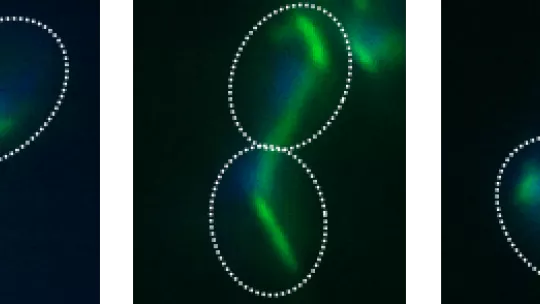Images
The HOG signalling pathway regulates the stress response in the yeast Saccharomyces cerevisiae and halts cell division, thereby regulating the segregation of chromosomes through protein Net1.
The p38 signalling pathway in humans is equivalent to that of HOG and is involved in tumour development.
The study by the Signaling Laboratory at IRB Barcelona has been published in the journal PNAS.
When cellular stress occurs due to exposure to a toxin, a pathogen, or an alteration in the extracellular environment, the cell must adapt to survive. Led by Eulàlia de Nadal and Francesc Posas, the Cell Signaling Laboratory at IRB Barcelona has described how yeast cells respond to stress by activating a mechanism that slows down cell division. On the one hand, this response allows the cell to produce the proteins required to protect itself and adapt to the new situation, while simultaneously avoiding cell division in suboptimal conditions, in which the probability of incorporating errors is higher.
Published in the journal PNAS, the study confirms that the HOG signalling pathway is responsible for the stress response in the yeast Saccharomyces cerevisiae. Specifically, the work describes how Net1 protein, when activated by the HOG pathway, blocks the cell cycle and cell division.
Cellular stress and disease
Cellular stress is related to many diseases, such as cancer and those associated with aging. Ensuring that the genome of a cell duplicates correctly and passes to the daughter cells intact is crucial for the maintenance of the cell lineage and the proper functioning of the body. "Under conditions of cellular stress, if the cycle is not regulated, the cell is prone to incorporating mutations," explains de Nadal. "These mutations can eventually trigger tumour and cancer development, which is why it is so important to fully understand the mechanisms that regulate the cycle," she adds.
In addition to cancer, cellular stress is also linked to various metabolic conditions, neuronal diseases and other pathologies associated with ageing.
Yeast as a study model
Model organisms are used in research because they offer a framework in which to conduct research quickly, safely and more economically. Research results must then be extrapolated (and adapted, if necessary) to the organism of interest, whether humans, other animals or plants. For this study, the Posas-de Nadal laboratory used the yeast Saccharomyces cerevisiae, a single-celled organism that is easy to manipulate in the laboratory and, unlike bacteria, is eukaryotic, that is to say, it has a nucleus and other membrane-bound organelles— features shared with human (animal) and plant cells. The phases of the cell cycle and the mechanisms of cell division are also the same, thereby making it an ideal model organism for studying the cell cycle.
Reference article:
Silvia Tognetti, Javier Jiménez, Matteo Viganò, Alba Duch, Ethel Queralt, Eulàlia de Nadal, and Francesc Posas
Hog1 activation delays mitotic exit via phosphorylation of Net1
PNAS (2020) DOI: https://doi.org/10.1073/pnas.1918308117
About IRB Barcelona
The Institute for Research in Biomedicine (IRB Barcelona) pursues a society free of disease. To this end, it conducts multidisciplinary research of excellence to cure cancer and other diseases linked to ageing. It establishes technology transfer agreements with the pharmaceutical industry and major hospitals to bring research results closer to society, and organises a range of science outreach activities to engage the public in an open dialogue. IRB Barcelona is an international centre that hosts 400 researchers and more than 30 nationalities. Recognised as a Severo Ochoa Centre of Excellence since 2011, IRB Barcelona is a CERCA centre and member of the Barcelona Institute of Science and Technology (BIST).







